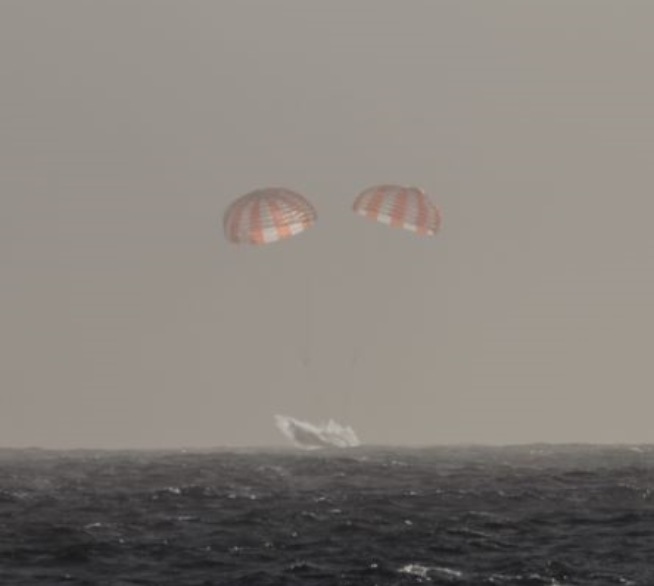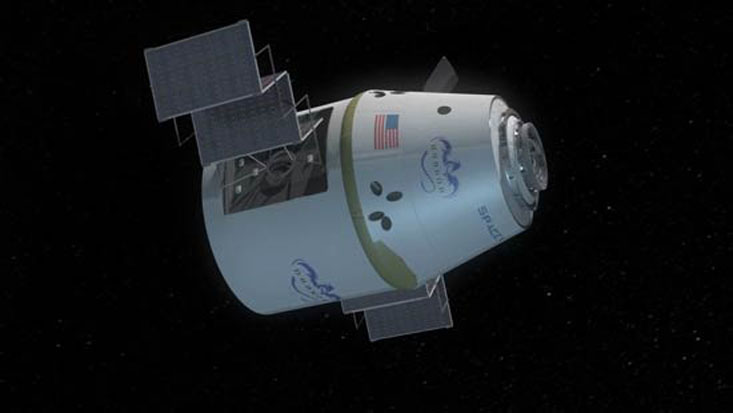
SpaceX's robotic Dragon capsule has come back to Earth, wrapping up a successful monthlong cargo mission to the International Space Station.
The Dragon spacecraft splashed down Tuesday (Feb. 10) at 7:44 p.m. EST (0044 GMT Feb. 11) in the Pacific Ocean off the coast of Baja California. The unmanned capsule had departed from the space station about 5 1/2 hours earlier, at 2:10 p.m. EST (1910 GMT).
SpaceX launched the Dragon capsule toward the space station on Jan. 10, using its own Falcon 9 rocket to loft the spacecraft. Two days later, Dragon delivered more than 5,000 lbs. (2,268 kilograms) of food, scientific experiments, spare parts and other cargo to the station. The capsule brought 3,700 lbs. (1,678 kg) of scientific supplies and other "down cargo" back to Earth Tuesday, NASA officials said. (Dragon is the only robotic spacecraft operating today that can return supplies to Earth; other vehicles are designed to burn up in the atmosphere.)
California-based SpaceX holds a $1.6 billion contract with NASA to fly 12 cargo missions to the space station using Dragon and the Falcon 9. The company has now completed five of these flights, all of them successful.
Another aerospace firm, Virginia-based Orbital ATK, secured a $1.9 billion deal to make eight resupply flights to the station for NASA using its Cygnus capsule and Antares rocket. The first two missions went well, but the third, in late October 2014, ended just seconds after liftoff when the Antares exploded.

Dragon's splashdown was supposed to be part of an extremely busy day for SpaceX. The company planned to launch the Deep Space Climate Observatory (DSCOVR) space-weather satellite using a Falcon 9 from Florida's Cape Canaveral Air Force Station Tuesday — and also attempt to bring the rocket's first stage back for a soft landing on a robotic ship in the Atlantic Ocean, in a test of reusable-rocket technology.
Strong high-altitude winds delayed the DSCOVR launch and rocket-flyback test, however; SpaceX will try again on Wednesday at 6:03 p.m. EST (2303 GMT).
Get the Space.com Newsletter
Breaking space news, the latest updates on rocket launches, skywatching events and more!
SpaceX has tried the ocean-landing maneuver once before, during Dragon's Jan. 10 launch. The bold move nearly worked — the Falcon 9 stage hit its drone ship target but came down too hard and exploded on the deck.
You can watch SpaceX's rocket launch on Wednesday, courtesy of NASA TV, beginning at 5 p.m. EST (2200 GMT).
Follow Mike Wall on Twitter @michaeldwall and Google+. Follow us @Spacedotcom, Facebook or Google+. Originally published on Space.com.
Join our Space Forums to keep talking space on the latest missions, night sky and more! And if you have a news tip, correction or comment, let us know at: community@space.com.

Michael Wall is a Senior Space Writer with Space.com and joined the team in 2010. He primarily covers exoplanets, spaceflight and military space, but has been known to dabble in the space art beat. His book about the search for alien life, "Out There," was published on Nov. 13, 2018. Before becoming a science writer, Michael worked as a herpetologist and wildlife biologist. He has a Ph.D. in evolutionary biology from the University of Sydney, Australia, a bachelor's degree from the University of Arizona, and a graduate certificate in science writing from the University of California, Santa Cruz. To find out what his latest project is, you can follow Michael on Twitter.
